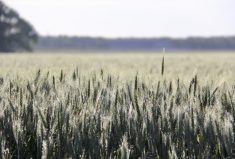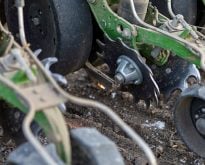While there may be short-term costs of improving soil health through longer rotations, the past growing season in Ontario has demonstrated that they can be a good investment.
“It’s one of those messages — especially in a year like 2022 — where there are growing seasons that bring it to the fore,” says Jake Munroe, soil management specialist with the Ontario Ministry of Agriculture, Food and Rural Affairs . “We did get rains in some areas, but there were others that were really dry throughout the summer, to the point where we’re going to see that impact on yields.”
Munroe believes growers are showing more interest in the subject in response to higher input costs in the past 16 months, particularly for nitrogen. That’s spurred growers to look at alternatives such as biologicals, or how to provide a nitrogen credit to corn from legumes or other cover crops. Those practices can help to do more with less or provide an immediate benefit through savings, but building that long-term resilience takes time and effort.
Read Also

Could crop sharing be a viable option for your farm?
Crop sharing could be a good option for young and beginning farmers.
“That is more the long-term, science-based effort in building cropping system resilience to weather stressors,” says Munroe. “It does not occur overnight but growers who’ve built their soil health through diversified rotations and other BMPs are reaping the benefits, especially where water stress can persist for many weeks.”
Grower interest on the rise
Munroe says growers aren’t asking specifically about improving soil resilience, but more about their land’s efficiency in bringing in more revenue without reducing future productivity. He’s heard of livestock producers wanting to make the best use of their acres with cover crops such as oats or triticale, which can be planted in fall and harvested in the spring. Ultimately, they want to know more about practices that will put more in the feed bunk and more in the pocketbook without harming the soil or long-term productivity.
Munroe says he asked David Hooker about his long-term rotation trials at the University of Guelph’s Ridgetown Campus. Regarding the benefits of rotations longer than three years, Hooker replied that it’s the frequency of small grains in rotation with corn and soybeans that provide the largest benefit. Another possibility comes with alfalfa or alfalfa-grass mixes, which require different management practices — and possibly different machinery — yet their root systems offer soil-building potential.
“There can be benefits for wider rotations in terms of pests and disease, for sure,” says Munroe. “But in soil building, it comes down to the frequency of those fibrous-rooted small grains and perennials in rotation.”
Balancing act
Deb Campbell says it’s a difficult balancing act to manage for both production and soil health, and echoes Munroe’s comment that it’s a long-term process. She says a “systems approach” is the key.
“It could be a diversified crop rotation or cover crops and manures, and an extra list that goes beyond just one or two items to a very multi-dimensional soil health strategy,” says Campbell, a certified crop advisor and owner of Agronomy Advantage. “Producers who have been implementing that for five, six or seven years are starting to gain output from it.”
She adds it’s easy to see the effect of a six-week stretch of no rainfall in well-managed fields. Although there’ll be curling of leaves in the afternoon, plants are still green and growing, while nearby fields that haven’t had those multi-dimensional practices are struggling, especially with one producer she knows.
“He was pulling off 50-plus bushel soybeans in a region of the province with no rain, and his neighbours were doing a tonne (37.5 bushels) to the acre. Soybeans are tied to moisture availability and by extension to water-cycling capacity, which are much better on healthy soils. There’s something going on that’s making 15- and 20-bushel differences, particularly in soybeans.”
Campbell is an advocate of the Farmland Health Checkup implemented by the Ontario Soil and Crop Improvement Association and covering the Lake Erie Agriculture Demonstrating Sustainability watershed. A producer can sit down with a CCA or agrologist and assign measurements to their management practices. The final score shows them where they’re excelling and where they have some weak points to address.
“Producers were quite engaged and it really provided a lot of focus on what’s working and where they could invest more resources to fix some of their challenges,” says Campbell. “It’s tied to soil health, water management and soil management, so making a connection to these higher-stress weather events doesn’t surprise me at all. Whether it’s too much water or not enough, the ability of those soils and the plants to still be productive is what we’re seeing in the fields.”
Campbell says growers who are building healthy soils are willing to pay the added costs for seed, inputs and organic amendments, because they know their soils will benefit. There’s better structure because of deeper rooting and they know there’s something to be gained.
Comparing tillage systems
It’s valuable to have long-term research data on crop rotations, especially since they offer a benchmark based on previous practices. Craig Drury, a research scientist at Agriculture and Agri-Food Canada’s Harrow research station, can look back on studies spanning 50 to 60 years. Back then, oats and forages were common crops since soybeans weren’t an option in most parts of Eastern Canada. Like Campbell and Munroe, Drury believes the addition of cereals is the most important factor leading to soil health and resilience. He refers to winter wheat in the same way as a cover crop, reducing the potential for erosion, extending the growing season by capturing sunlight in late fall and early spring and adding to the soil carbon stocks.
Conservation tillage can also be used in conjunction with crop rotations. Drury cites one study at Woodslee that tested three treatments with a three-year rotation. No till, zone till and conventional till were employed with a corn-soybean-winter wheat rotation.
“What was really curious was that the highest soil carbon level of those three systems was with zone tillage, as it had about 12 per cent higher than no till or conventional till,” he says. “It’s like a bank account: the zone till had similar yields and crop residue carbon inputs to the conventional till for most years, because the conditions at planting were very good for the zone till.”
The soil in the zone wasn’t as saturated as no till and temperatures were a bit warmer than no till, enhancing seedbed conditions, with faster emergence similar to conventional till with comparable yields. The zone till had similar inputs as the conventional till but from the output side, the highest decomposition was with the conventional till because with plowing, inverting and mixing the soil, the microbes had easy access to break down the soil carbon and release most of it as carbon dioxide to the air.
“The highest decomposition of plant carbon occurred in the conventional till,” says Drury. “The zone till and no till had lower decomposition of the carbon, so like a bank account, the withdrawals were lower for the zone till and no till while the inputs were higher for the conventional till and zone till. The net result was we started building carbon stocks with the zone till over time.”
Drury says climate change will increase the importance of building soil organic matter. With finely textured soils (clays, clay-loams, loams), higher organic carbon means better structure. It’s that whole process — the way of looking at resilience and trying to come up with ways to start building that carbon back — especially in systems where it’s been lost over time.
















